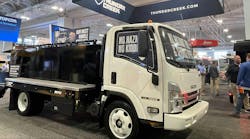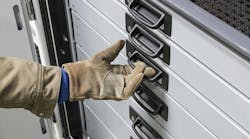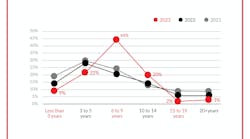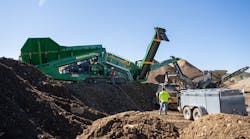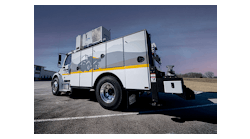Mechanics trucks might not always be thought of as the heroes of the job site, but in many respects they are. When equipment breaks down and productivity stops, the mechanics truck swoops in, fixes the problem and brings dreaded downtime to a halt – in a sense saving the day. But how effective would Superman be if he had a broken leg?
It’s a bit ironic that mechanics trucks – whose sole purpose is usually maintenance and repair – often get the short end of the maintenance stick?
"If a piece of equipment goes down and it can’t be repaired in a timely manner because the crane on your mechanics truck is out of commission due to a neglected preventive maintenance (PM) schedule, then you are losing money," says Tim Worman, product manager of commercial vehicles at Iowa Mold Tooling Co. Inc. (IMT), a service truck and crane manufacturer.
Mechanics truck owners are typically pretty good about keeping up on the chassis’ PM schedule, but they often forget to be as diligent about other components of the service body, such as the crane and the air compressor. But an out-of-commission crane is just as detrimental to your fleet’s productivity as the service truck’s engine going out.
"What people don’t often realize," Worman says, "is that mechanics trucks are a revenue generator. It’s still a common misconception that these trucks are a cost center, a ‘necessary evil.’ That is far from the truth. A well-maintained and productive mechanics truck puts dollars back directly to your bottom line. Time is money, and downtime is the greatest enemy of profitability in a construction equipment fleet. There is no faster, more efficient way to repair equipment than on the job site. But only if you take good care of your mechanics trucks to ensure that they are available whenever they are needed."
Worman says that IMT’s Dominator® mechanics trucks are known for their durability and can withstand the tough conditions of any job site. He says that Dominator bodies often outlive multiple chassis before they need to be replaced, and they enjoy these long lives with very little maintenance. The bodies themselves are fairly maintenance-free.
The crane and air compressor – components added to the majority of mechanics trucks – are another story, however. Worman says IMT telescopic cranes and air compressors are also very durable and reliable and can last out in the field for many years, but only if the daily, monthly, quarterly, and annual maintenance and inspections are performed diligently.
Service Crane PM Schedule
Mechanics trucks can have a variety of crane sizes with different lifting capacities, but the PM procedures are essentially the same for all hydraulic telescopic service cranes. IMT’s Worman provided details on his company’s PM schedules for its telescopic cranes as an example of an appropriate maintenance routine. All of the following intervals are IMT’s recommendations, so details might be different than those from other crane manufacturers. Always consult the operators manual for equipment-specific information.
There are a variety of inspections that must be done daily, including:
- All safety devices for proper operation
- Controls for leaks, cracks and proper operation of all functions
- Hydraulic system (hoses, tubes and fittings) for leakage and proper oil level
- Crane hook’s safety latches and proper operation
- Wire rope for proper reeving on sheaves and winch drums
- Connecting pins and pin-retaining devices for proper engagement
- Overall crane for damaged/missing parts or cracked welds; observe crane during operation for abnormal performance
- Lights and alarms for proper operation
- Anti 2-block device for proper operation
Additional inspections and services must be done either monthly or after 100 hours of operation, whichever comes first. An hour of operation is the same as 20 complete cycles, so if you are performing more than 20 cycles in an hour, you should adjust the maintenance schedule accordingly. In addition to daily inspection items, recommended monthly inspections include:
- Cylinders for leakage at rod, fittings and welds, as well as damage to rod and case
- Holding valves for proper operation
- Control valves for leaks at fittings and between stations, and control valve linkages for wear, smoothness of operation and tightness of fasteners
- Electrical systems for presence of dirt, moisture and frayed wires
- All welds for breaks and cracks
- All pins for proper installation and condition
- Bolts, fasteners and retaining rings for tightness, wear and corrosion
- Hydraulic pumps and motors for leakage at fittings, seals and between sections, as well as quality of hydraulic fluid and presence of water
- Transmission/PTO for leakage, abnormal vibration and noise
- Hoses and tubes for leakage, abrasion damage, blistering, cracking, and deterioration must fit leakage and be properly secured
- Load hook for abnormal throat distance, twist, wear, and cracks
Quarterly maintenance items must be done either every three or four months or 300 hours of operation, whichever comes first, and must also include daily and monthly items. Recommended quarterly inspections and services include:
- Wear pads for general condition
- Rotation bearing for proper torque of all accessible mounting bolts
- Base mounting bolts for proper torque
- Crane structural components (base, outriggers, mast, inner boom, outer boom, extensions, jib booms, and extensions) for deformation, cracks and corrosion
- Pins, bearing, shafts, gears, rollers, and locking devices for wear, cracks, corrosion, and distortion
- Hydraulic lines, hoses, fittings, and tubing for leakage, blistering, deformation, excessive abrasion, and proper routing
- All hydraulic valves for cracks, spool return to neutral, sticking spools, proper relief valve setting, and relief valve failure
- Hydraulic cylinders for drifting, rod-seal leakage and leakage at welds; rods for nicks, scores and dents; case and rod ends for damage and abnormal wear
- Hydraulic filters for replacement per maintenance schedule
- All pumps, PTOs and motors (including winch and rotation motors) for loose
bolts/fasteners, leaks, noise, vibration, loss of performance, heating, and excess pressure - Winch, sheaves and drums for damage, abnormal wear, abrasions, and other irregularities
Annual service items must be done either yearly or every 1,200 hours, whichever comes first. In addition to the daily, monthly and quarterly inspection items, services scheduled annually include:
- Hydraulic fluid change
- Control and safety valve calibration for correct pressure and relief valve settings
- Check all valves to ensure they maintain the correct settings
- Inspect rotation drive system for proper backlash clearance and abnormal wear, deformation and cracks
- Gear oil change in rotation drive system
- Check tightness of all fasteners and bolts, using torque specifications on component drawings or torque chart
- Inspect loadline for proper attachment to drum
Wire Rope and Hook Inspection
"A compromised wire rope should be replaced immediately," Worman says. "This is a critical safety issue, and no one should ever cut corners here. That’s why wire rope is one of the daily inspection items; it’s not something you should ever let slide."
There are a number of characteristics to look for in your wire rope, some requiring immediate replacement and some indicating the rope should be monitored very closely. Corrosion, depending on its severity, might be cause for replacement or at the very least noted and carefully monitored. Other reasons a wire rope might need to be replaced include:
- Three broken wires in one strand or a total of six broken wires
- Flat spots on the outer wires
- A decrease in diameter that indicates a core failure, or when the diameter is reduced by 1/32 inch or more
- Distortion such as kinking, crushing or birdcaging
- Noticeable discoloration caused by heat damage
- Broken wire protruding or looping out from the core of the rope
Hooks are also a critical component and must be monitored closely for safety reasons, which is why they are a daily inspection item. A deficient hook must be removed from service right away, and if it is repaired and approved for use again then it should be inspected more often. Hooks should be removed and repaired if any of the following conditions are present:
- Bending or twisting
- Increased throat opening
- Wear that exceeds 10 percent of the original dimension
- Cracks, nicks or gouges
- Deformed or malfunctioning latch
Air Compressor PM Schedule
The air compressor is another critical service truck component that often doesn’t receive the attention it deserves when it comes to maintenance. Just like the crane, the air compressor has inspection and service items that must be performed at different intervals – daily, weekly, quarterly, and semiannually.
On a new air compressor, the cylinder head stud torque must be checked after the initial eight to 10 hours of operation, and the compressor must be at room temperature before re-torquing the studs.
Every day, the crankcase oil level must be checked and supplemented if necessary, and condensation should be drained from the air receiver. Fittings and air lines must also be checked for leaks. On a weekly basis, the air intake should be inspected, and valves and cylinder head stud torque need to be checked.
Quarterly or every 250 hours, whichever comes first, the crankcase oil must be changed and the cooling vanes must be cleaned, as well as the safety valves. All valves must also be tightened and checked for carbon buildup, and electrical connections need to be inspected. Every six months or 500 hours, whichever comes first, the drive coupling must be inspected for wear, and the air cleaner must be changed.
A well-run fleet needs a well-maintained mechanics truck in order to keep the equipment in the dirt and earning money. Even companies that are diligent about PM schedules for their equipment can be lax when it comes to caring for the trucks that keep the equipment up and running. Making PM just as much a priority for your service trucks as you do for your other equipment is well worth the time investment.
Jennifer Oredson is a writer for Two Rivers Marketing, Des Moines, IA.Article provided by Iowa Mold Tooling Co. Inc., Garner, IA.
